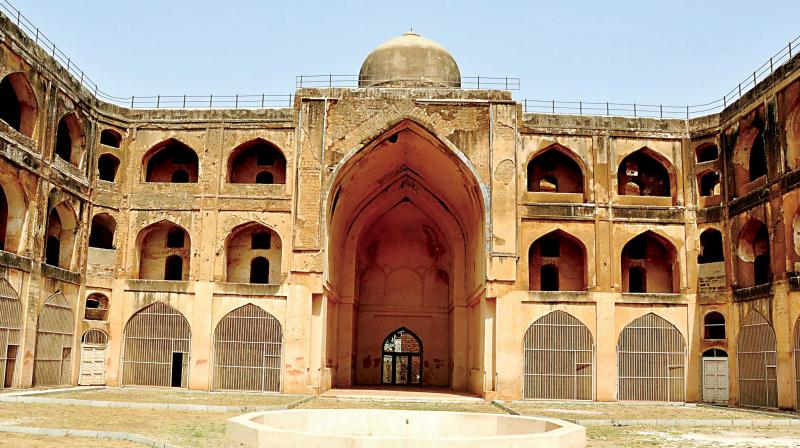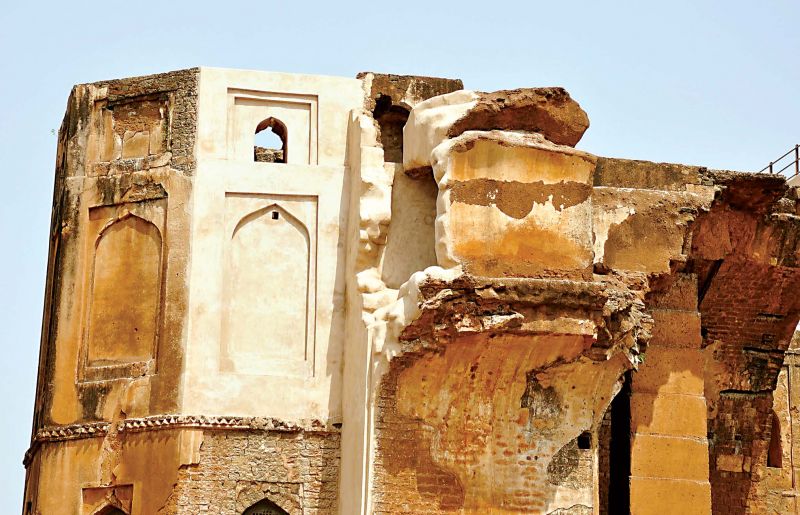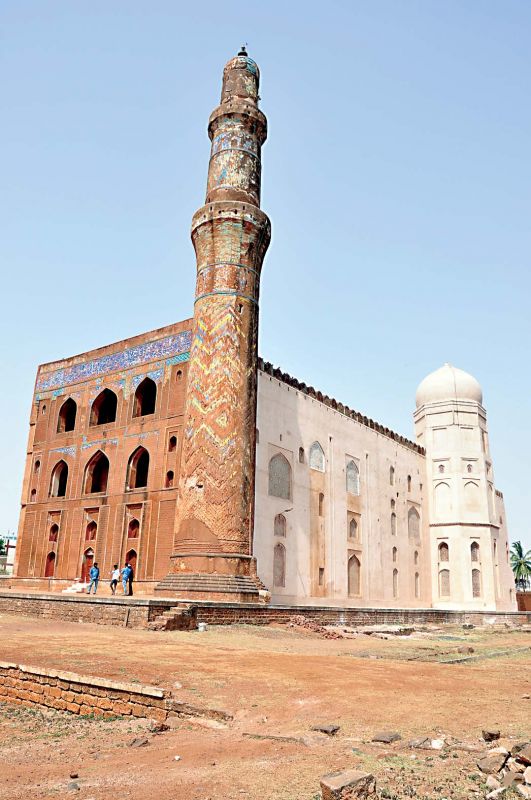A treasure trove of knowledge waiting for redemption

From the Platonic Academy in Athens to the Library of Alexandria, from Nalanda and Taxila to the Mahamud Gawan Madarsa in our own Bidar, ancient centres of learning grew and flourished under the patronage of benevolent kings who know that learning was the only crucible in which a civilised and wealthy society could grow. Scholars from faraway lands would reach these centres to imbibe knowledge and spread the light wherever they went. In Bidar, the walls of the Mahamud Gawan Madarsa, patronised by the Bahmani kings and their successors in the 15th century, may have seen thousands of young and aspiring scholars come and go, adding their profound thoughts and ideas to the rich world of knowledge . K.N. Reddy profiles the Madarasa, which is considered the first Islamic college in South India and is now under renovation though the pace of work has been lacklustre to say the least, despite its monumental historic value.
Bidar City, also known as ‘Karnatakada Kireeta’ in view of its location in the north-eastern part of the state, is well known for its many sites of architectural, historic and religious importance. Some of them are the Bidar Fort, Narasimha Jharna, Gurunanak Jharna and Papanasha Temple.
Owing to its rich heritage, the city has a prominent place on the Archaeological Map of India. According to the book ‘Bidar Heritage’ published by the state Department of Archaeology, Museums and Heritage, of the 61 monuments listed by the department, about 30 are tombs located in and around Bidar city, which explains its nickname, ‘City of Whispering Monuments.’ The heritage sites in and around Bidar have become a major attraction for film shooting in recent years with Bollywood making visits apart from the Kannada film industry.

The Mahamud Gawan Madarsa is one such important monument in the city. Its renovation by the ASI at a cost of Rs 17 lakhs has brought cheer not only to connoisseurs of history but also the common man who was eager to see the emergence of Bidar City as a major tourist destination.

The ASI has renovated the Madarsa by strengthening the ceiling and also the dome with mortar. About ten years ago when Mr Harsha Gupta was the deputy commissioner of Bidar, he launched renovation of the structure to help attract tourists. “In the first phase, a compound wall was constructed in front and grills were installed to protect the structure. Now with a view to strengthen the structure which had weakened considerably due to the seepage of rain water into the walls, the gaps have been sealed with mortar. In the next phase, a compound wall will be constructed at the back”, says a senior official of ASI.
Mahamud Gawan was no ordinary mortal, he became the Prime Minister of the Bahmani kingdom in 1466 and was a notable figure in the history of Bidar which remained under the Barid Shahi dynasty, until its conquest by the Bijapur Sultanate in 1619.
Gawan had come to India from Iran for trading. Well educated and intelligent, he drew the attention of Bahmani Sultan Allauddin and he included him in his inner circle of administrators. Sultan Humayun who ruled next, recognised the calibre of Gawan and appointed him as Maliknayib.
Mahamud Gawan was not only a great administrator but also a brave general. It was because of him that the Bahmani Kingdom expanded though weak and incompetent rulers like Humayun, Nizam Shah and Muhammad Shah III were at the helm of affairs. He waged successful wars against the rulers of Sangameshwar, Vijayanagar, Konkan, and Orissa and wrested many important territories from them. From the Vijayanagar rulers, he snatched the important port of Goa. When the Bahmani rulers were busy in their pursuits of pleasure and in wars, he was busy organizing the administrative machinery on scientific lines. He was also a great patron of art, literature and education and established various schools and colleges for the promotion of education among the illiterate.
Gawan was rich due to his international trade but spent his entire earnings on the promotion of education. In 1472 AD, he built a three storied building for housing a college at Bidar, the new capital of the Bahmani kingdom. This college later on, came to be known after him as ‘Mahamud Gawan’s Madrasa. It was modelled on the same lines as the renowned Islamic colleges at Samarkhand and Khorasan.
The Bidar Madrasa had an imposing three-storey building with 100 feet tall minarets in four corners. There were thrity-six rooms for students and six suites for teaching staff. It also had big lecture halls, a prayer hall and a matchless library of three thousand volumes. Gawan himself had a personal library of more than a thousand books. He used to spend all his leisure time in the library.
The Madrasa building had a large courtyard with nearly a thousand cubicles where students and learned men who came from all parts of the country and elsewhere, would stay. Gawan was fond of the company of the learned and after a day’s toil, used to sit with them and enjoy their company. He tried to get renowned scholars from Persia and other West-Asian countries for teaching and for heading the now famous college. But most of them declined the offer due to age and the arduous journey to Bidar. Sheikh Ibrahim Multani became head of the Madrasa and finally, chief Kazi of the kingdom and is credited with the spread of Islamic learning in the state.
Despite its iconic value, work on the renovation of the Madrasa and on the proposed Mahamud Gawan Research Centre has remained in limbo even two years after the release of Rs 1 crore by the state government. With a view to enlighten the present generation about the contributions of Gawan, the state government had announced setting up of the centre. Except for opening a cell under the Department of Minority Welfare and deputing two officers, nothing significant has happened so far. No permanent staff has been appointed or transferred from other departments here.
“We have set up an adhoc office in our department, deploying two officers for the purpose. Soon the Deputy Commissioner will be urged to convene a meeting to review the progress”, said a senior officer of the Department of Minority Welfare. The state government has released funds for constructing the Centre’s building at the nearby Kabeerwadi village where land has been identified for the purpose. Steps are on to prepare estimates for the building. But the pace of work leaves a lot to be desired. But the lack of initiative has left the ancient structure in the same state as it was for centuries.
If we have reached an age of enlightenment where nothing seems to be impossible-not even reaching out to the heavens, it’s all because of the never ending churning in the world of knowledge which helped us breach new frontiers in our thought processes. Ancients centres like the one in Bidar have to be preserved so that they remain in the minds of present and future generations as symbols of the eternal thirst for knowledge which has helped us progress from an age of ignorance to masters of the universe. The big question remains-have we done even a fraction of what the ancient rulers did to preserve and foster the hunger for wisdom?
Bidar, a tourist hub waiting to be developed
It’s not Mahamud Gavan Madarsa alone which is being renovated, steps have been launched for the comprehensive development of tourism in Bidar district. The tourism department is learnt to have sent proposals to the Union government seeking Rs 111 crore to set up a Royal Deccan Tourism circuit in north Karnataka under the Swadesh Darshan and Rs 500 crore for the development of heritage sites in Bidar district under HRUDAY scheme. The state government has also sanctioned Rs 10 crore for making Bidar a model tourist destination. This project is aimed at not only giving more information to tourists and for promoting tourism destinations, but also to ensure visitors are treated well when they are here. It will include training of guides, creating amenities for tourists such as drinking water facilities and toilets, creating easy access to tourist spots and promoting infrastructure like quality hotels besides ensuring cleanliness, The Bidar City Municipal Council has also identified 470 parks on 400 acres for development and beautification.

